Comprehensive Report on Manufacturing Systems and Performance
VerifiedAdded on 2023/04/21
|21
|5869
|72
Report
AI Summary
This report provides a comprehensive overview of manufacturing systems, encompassing key performance indicators (KPIs), plant layouts, product flow analysis (PFA), and value stream mapping (VSM). It explores the role of KPIs in evaluating manufacturing task performance and discusses developments in manufacturing systems aimed at addressing competitiveness issues. The report details an approach for establishing performance measures at the shop floor level, including product/batch production, and explains how these measures can be implemented to achieve corporate objectives. It elucidates PFA and VSM, demonstrating their application in manufacturing companies. Different types of plant layouts are described, along with their benefits related to production varieties, volume, and economies of scale. The report offers a critical review and comparison of process improvement tools and techniques within lean manufacturing systems and defines several acronyms relevant to manufacturing processes such as CNC, CAD, BOM, CAM, CAPP, AGV, MPS, MRP, FMS, CIM, and ERP. Finally, it includes a case study on the performance assessment of a manufacturing plant, utilizing provided data to analyze and evaluate its operational efficiency.

Running head: MANUFACTURING SYSTEMS
Manufacturing Systems
Name of the Student
Name of the University
Author’s Note:
Manufacturing Systems
Name of the Student
Name of the University
Author’s Note:
Paraphrase This Document
Need a fresh take? Get an instant paraphrase of this document with our AI Paraphraser
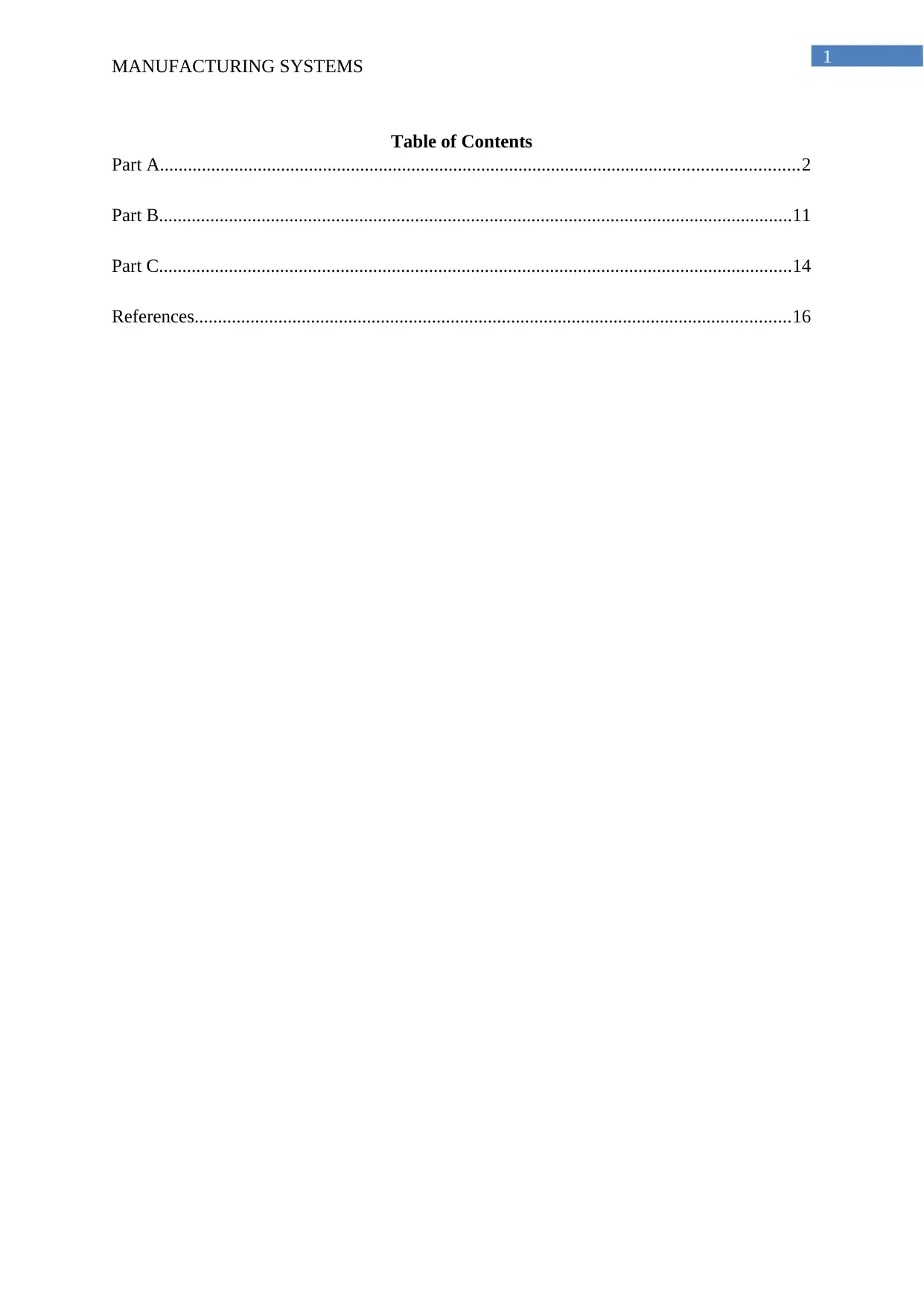
1
MANUFACTURING SYSTEMS
Table of Contents
Part A.........................................................................................................................................2
Part B........................................................................................................................................11
Part C........................................................................................................................................14
References................................................................................................................................16
MANUFACTURING SYSTEMS
Table of Contents
Part A.........................................................................................................................................2
Part B........................................................................................................................................11
Part C........................................................................................................................................14
References................................................................................................................................16
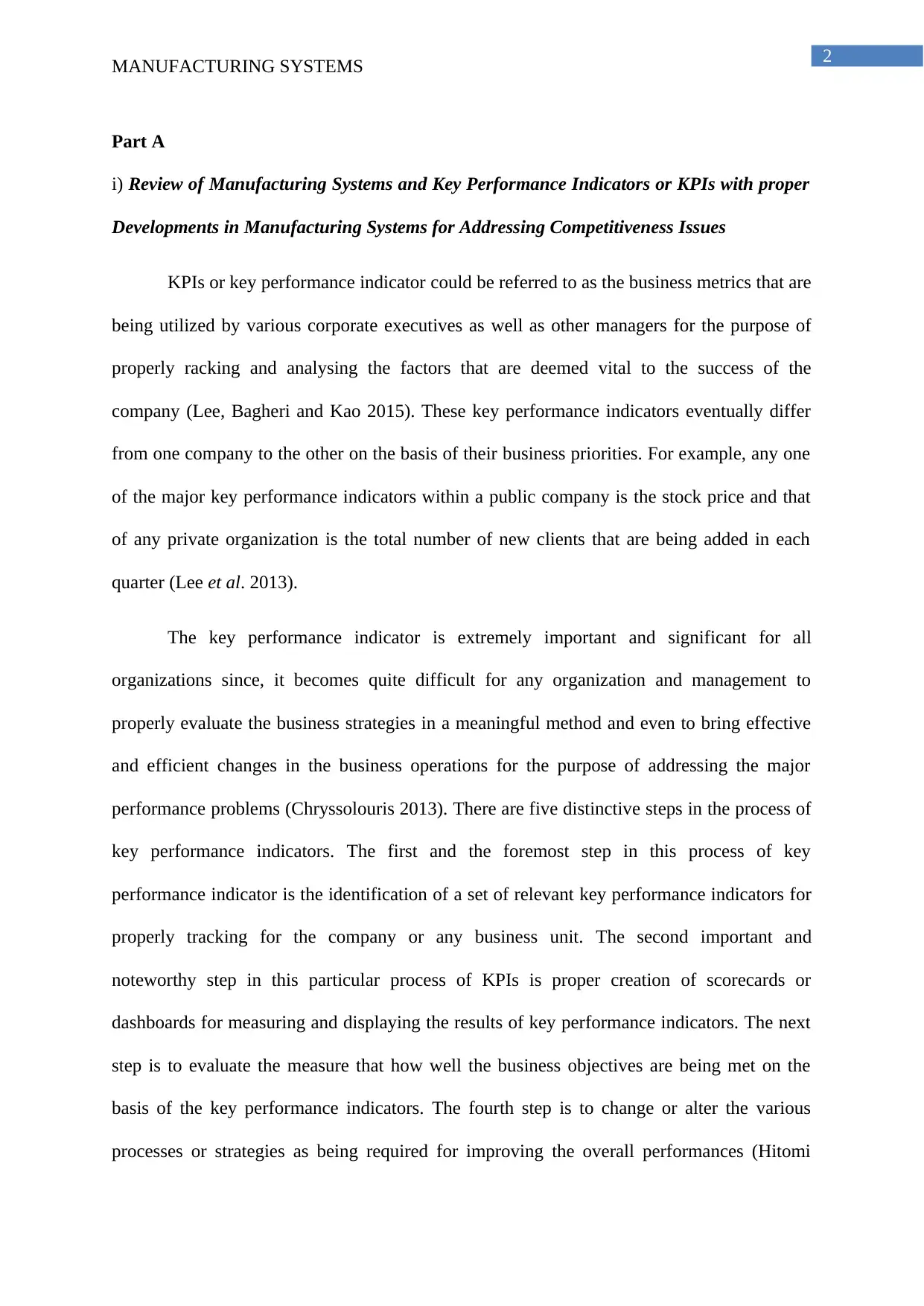
2
MANUFACTURING SYSTEMS
Part A
i) Review of Manufacturing Systems and Key Performance Indicators or KPIs with proper
Developments in Manufacturing Systems for Addressing Competitiveness Issues
KPIs or key performance indicator could be referred to as the business metrics that are
being utilized by various corporate executives as well as other managers for the purpose of
properly racking and analysing the factors that are deemed vital to the success of the
company (Lee, Bagheri and Kao 2015). These key performance indicators eventually differ
from one company to the other on the basis of their business priorities. For example, any one
of the major key performance indicators within a public company is the stock price and that
of any private organization is the total number of new clients that are being added in each
quarter (Lee et al. 2013).
The key performance indicator is extremely important and significant for all
organizations since, it becomes quite difficult for any organization and management to
properly evaluate the business strategies in a meaningful method and even to bring effective
and efficient changes in the business operations for the purpose of addressing the major
performance problems (Chryssolouris 2013). There are five distinctive steps in the process of
key performance indicators. The first and the foremost step in this process of key
performance indicator is the identification of a set of relevant key performance indicators for
properly tracking for the company or any business unit. The second important and
noteworthy step in this particular process of KPIs is proper creation of scorecards or
dashboards for measuring and displaying the results of key performance indicators. The next
step is to evaluate the measure that how well the business objectives are being met on the
basis of the key performance indicators. The fourth step is to change or alter the various
processes or strategies as being required for improving the overall performances (Hitomi
MANUFACTURING SYSTEMS
Part A
i) Review of Manufacturing Systems and Key Performance Indicators or KPIs with proper
Developments in Manufacturing Systems for Addressing Competitiveness Issues
KPIs or key performance indicator could be referred to as the business metrics that are
being utilized by various corporate executives as well as other managers for the purpose of
properly racking and analysing the factors that are deemed vital to the success of the
company (Lee, Bagheri and Kao 2015). These key performance indicators eventually differ
from one company to the other on the basis of their business priorities. For example, any one
of the major key performance indicators within a public company is the stock price and that
of any private organization is the total number of new clients that are being added in each
quarter (Lee et al. 2013).
The key performance indicator is extremely important and significant for all
organizations since, it becomes quite difficult for any organization and management to
properly evaluate the business strategies in a meaningful method and even to bring effective
and efficient changes in the business operations for the purpose of addressing the major
performance problems (Chryssolouris 2013). There are five distinctive steps in the process of
key performance indicators. The first and the foremost step in this process of key
performance indicator is the identification of a set of relevant key performance indicators for
properly tracking for the company or any business unit. The second important and
noteworthy step in this particular process of KPIs is proper creation of scorecards or
dashboards for measuring and displaying the results of key performance indicators. The next
step is to evaluate the measure that how well the business objectives are being met on the
basis of the key performance indicators. The fourth step is to change or alter the various
processes or strategies as being required for improving the overall performances (Hitomi
⊘ This is a preview!⊘
Do you want full access?
Subscribe today to unlock all pages.

Trusted by 1+ million students worldwide
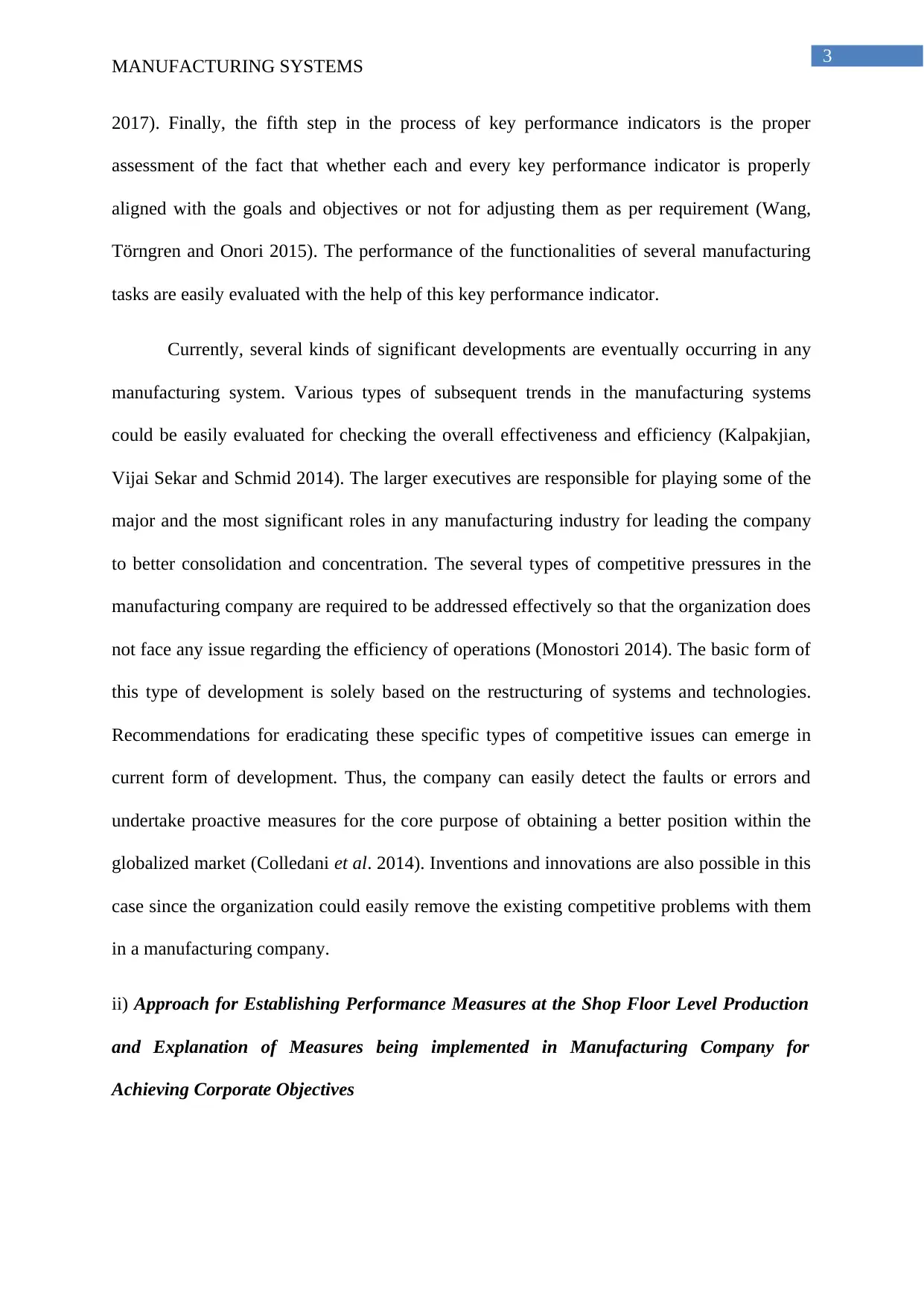
3
MANUFACTURING SYSTEMS
2017). Finally, the fifth step in the process of key performance indicators is the proper
assessment of the fact that whether each and every key performance indicator is properly
aligned with the goals and objectives or not for adjusting them as per requirement (Wang,
Törngren and Onori 2015). The performance of the functionalities of several manufacturing
tasks are easily evaluated with the help of this key performance indicator.
Currently, several kinds of significant developments are eventually occurring in any
manufacturing system. Various types of subsequent trends in the manufacturing systems
could be easily evaluated for checking the overall effectiveness and efficiency (Kalpakjian,
Vijai Sekar and Schmid 2014). The larger executives are responsible for playing some of the
major and the most significant roles in any manufacturing industry for leading the company
to better consolidation and concentration. The several types of competitive pressures in the
manufacturing company are required to be addressed effectively so that the organization does
not face any issue regarding the efficiency of operations (Monostori 2014). The basic form of
this type of development is solely based on the restructuring of systems and technologies.
Recommendations for eradicating these specific types of competitive issues can emerge in
current form of development. Thus, the company can easily detect the faults or errors and
undertake proactive measures for the core purpose of obtaining a better position within the
globalized market (Colledani et al. 2014). Inventions and innovations are also possible in this
case since the organization could easily remove the existing competitive problems with them
in a manufacturing company.
ii) Approach for Establishing Performance Measures at the Shop Floor Level Production
and Explanation of Measures being implemented in Manufacturing Company for
Achieving Corporate Objectives
MANUFACTURING SYSTEMS
2017). Finally, the fifth step in the process of key performance indicators is the proper
assessment of the fact that whether each and every key performance indicator is properly
aligned with the goals and objectives or not for adjusting them as per requirement (Wang,
Törngren and Onori 2015). The performance of the functionalities of several manufacturing
tasks are easily evaluated with the help of this key performance indicator.
Currently, several kinds of significant developments are eventually occurring in any
manufacturing system. Various types of subsequent trends in the manufacturing systems
could be easily evaluated for checking the overall effectiveness and efficiency (Kalpakjian,
Vijai Sekar and Schmid 2014). The larger executives are responsible for playing some of the
major and the most significant roles in any manufacturing industry for leading the company
to better consolidation and concentration. The several types of competitive pressures in the
manufacturing company are required to be addressed effectively so that the organization does
not face any issue regarding the efficiency of operations (Monostori 2014). The basic form of
this type of development is solely based on the restructuring of systems and technologies.
Recommendations for eradicating these specific types of competitive issues can emerge in
current form of development. Thus, the company can easily detect the faults or errors and
undertake proactive measures for the core purpose of obtaining a better position within the
globalized market (Colledani et al. 2014). Inventions and innovations are also possible in this
case since the organization could easily remove the existing competitive problems with them
in a manufacturing company.
ii) Approach for Establishing Performance Measures at the Shop Floor Level Production
and Explanation of Measures being implemented in Manufacturing Company for
Achieving Corporate Objectives
Paraphrase This Document
Need a fresh take? Get an instant paraphrase of this document with our AI Paraphraser

4
MANUFACTURING SYSTEMS
Within any manufacturing company, the respective and accurate measurement of
performance is one of the major and the most important requirement (Chen, Li and Zhou
2014). This specific technique of performance measurement can be easily applied in the
organization on the basis of measurement at the core level of performance that is being made
by the company. The major indirect methodologies of measures on the basis of performance
are also evaluated effectively and efficiently. Moreover, this measurement of performance is
also subsequently applicable to the costing of operation in any organization. Important and
noteworthy types of methodologies or planning techniques on the basis of scheduling are also
developed for the proper utilization within manufacturing industries (Wu et al. 2013). The
major types of approaches on the basis of modelling are also highly needed in such systems
and there are some of the basic approaches that are being utilized by production plant
management for the core purpose of prioritizing the product quality eventually.
The approach of simple heuristic is termed as the one of the most basic and important
approach within the level of shop floor and it is quite helpful for providing definition to the
sequencing of several optimal products on the basis of the due data within one single machine
of manufacturing (Jeschke et al. 2017). In simple heuristic, each and every model that is
based on the linear programming are being developed and it is majorly applied to solve
several types of problems. Simple heuristic approaches are also applicable to the larger scale
constraint satisfaction as well as scheduling issues. Most of the popular or famous
manufacturing organizations have applied this particular approach in their business and it has
been helpful to the several scheduling operations on the basis of exploiting the critical path in
network.
The next important and significant approach that is quite popular and is being utilized
in the manufacturing companies is termed as the model of linear programming (Putnik et al.
2013). This particular model is absolutely dependent on the synchronized and systematic
MANUFACTURING SYSTEMS
Within any manufacturing company, the respective and accurate measurement of
performance is one of the major and the most important requirement (Chen, Li and Zhou
2014). This specific technique of performance measurement can be easily applied in the
organization on the basis of measurement at the core level of performance that is being made
by the company. The major indirect methodologies of measures on the basis of performance
are also evaluated effectively and efficiently. Moreover, this measurement of performance is
also subsequently applicable to the costing of operation in any organization. Important and
noteworthy types of methodologies or planning techniques on the basis of scheduling are also
developed for the proper utilization within manufacturing industries (Wu et al. 2013). The
major types of approaches on the basis of modelling are also highly needed in such systems
and there are some of the basic approaches that are being utilized by production plant
management for the core purpose of prioritizing the product quality eventually.
The approach of simple heuristic is termed as the one of the most basic and important
approach within the level of shop floor and it is quite helpful for providing definition to the
sequencing of several optimal products on the basis of the due data within one single machine
of manufacturing (Jeschke et al. 2017). In simple heuristic, each and every model that is
based on the linear programming are being developed and it is majorly applied to solve
several types of problems. Simple heuristic approaches are also applicable to the larger scale
constraint satisfaction as well as scheduling issues. Most of the popular or famous
manufacturing organizations have applied this particular approach in their business and it has
been helpful to the several scheduling operations on the basis of exploiting the critical path in
network.
The next important and significant approach that is quite popular and is being utilized
in the manufacturing companies is termed as the model of linear programming (Putnik et al.
2013). This particular model is absolutely dependent on the synchronized and systematic
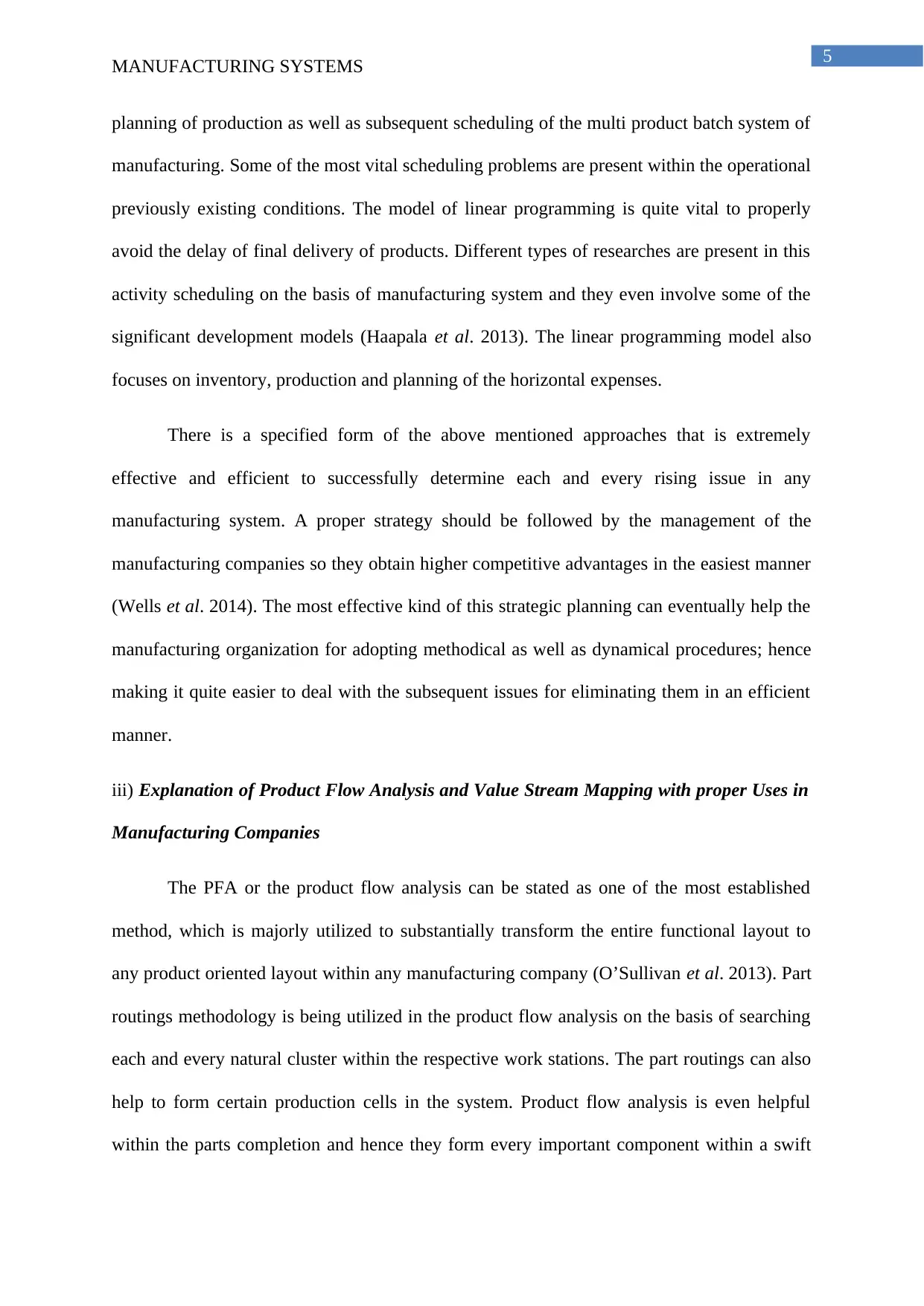
5
MANUFACTURING SYSTEMS
planning of production as well as subsequent scheduling of the multi product batch system of
manufacturing. Some of the most vital scheduling problems are present within the operational
previously existing conditions. The model of linear programming is quite vital to properly
avoid the delay of final delivery of products. Different types of researches are present in this
activity scheduling on the basis of manufacturing system and they even involve some of the
significant development models (Haapala et al. 2013). The linear programming model also
focuses on inventory, production and planning of the horizontal expenses.
There is a specified form of the above mentioned approaches that is extremely
effective and efficient to successfully determine each and every rising issue in any
manufacturing system. A proper strategy should be followed by the management of the
manufacturing companies so they obtain higher competitive advantages in the easiest manner
(Wells et al. 2014). The most effective kind of this strategic planning can eventually help the
manufacturing organization for adopting methodical as well as dynamical procedures; hence
making it quite easier to deal with the subsequent issues for eliminating them in an efficient
manner.
iii) Explanation of Product Flow Analysis and Value Stream Mapping with proper Uses in
Manufacturing Companies
The PFA or the product flow analysis can be stated as one of the most established
method, which is majorly utilized to substantially transform the entire functional layout to
any product oriented layout within any manufacturing company (O’Sullivan et al. 2013). Part
routings methodology is being utilized in the product flow analysis on the basis of searching
each and every natural cluster within the respective work stations. The part routings can also
help to form certain production cells in the system. Product flow analysis is even helpful
within the parts completion and hence they form every important component within a swift
MANUFACTURING SYSTEMS
planning of production as well as subsequent scheduling of the multi product batch system of
manufacturing. Some of the most vital scheduling problems are present within the operational
previously existing conditions. The model of linear programming is quite vital to properly
avoid the delay of final delivery of products. Different types of researches are present in this
activity scheduling on the basis of manufacturing system and they even involve some of the
significant development models (Haapala et al. 2013). The linear programming model also
focuses on inventory, production and planning of the horizontal expenses.
There is a specified form of the above mentioned approaches that is extremely
effective and efficient to successfully determine each and every rising issue in any
manufacturing system. A proper strategy should be followed by the management of the
manufacturing companies so they obtain higher competitive advantages in the easiest manner
(Wells et al. 2014). The most effective kind of this strategic planning can eventually help the
manufacturing organization for adopting methodical as well as dynamical procedures; hence
making it quite easier to deal with the subsequent issues for eliminating them in an efficient
manner.
iii) Explanation of Product Flow Analysis and Value Stream Mapping with proper Uses in
Manufacturing Companies
The PFA or the product flow analysis can be stated as one of the most established
method, which is majorly utilized to substantially transform the entire functional layout to
any product oriented layout within any manufacturing company (O’Sullivan et al. 2013). Part
routings methodology is being utilized in the product flow analysis on the basis of searching
each and every natural cluster within the respective work stations. The part routings can also
help to form certain production cells in the system. Product flow analysis is even helpful
within the parts completion and hence they form every important component within a swift
⊘ This is a preview!⊘
Do you want full access?
Subscribe today to unlock all pages.

Trusted by 1+ million students worldwide
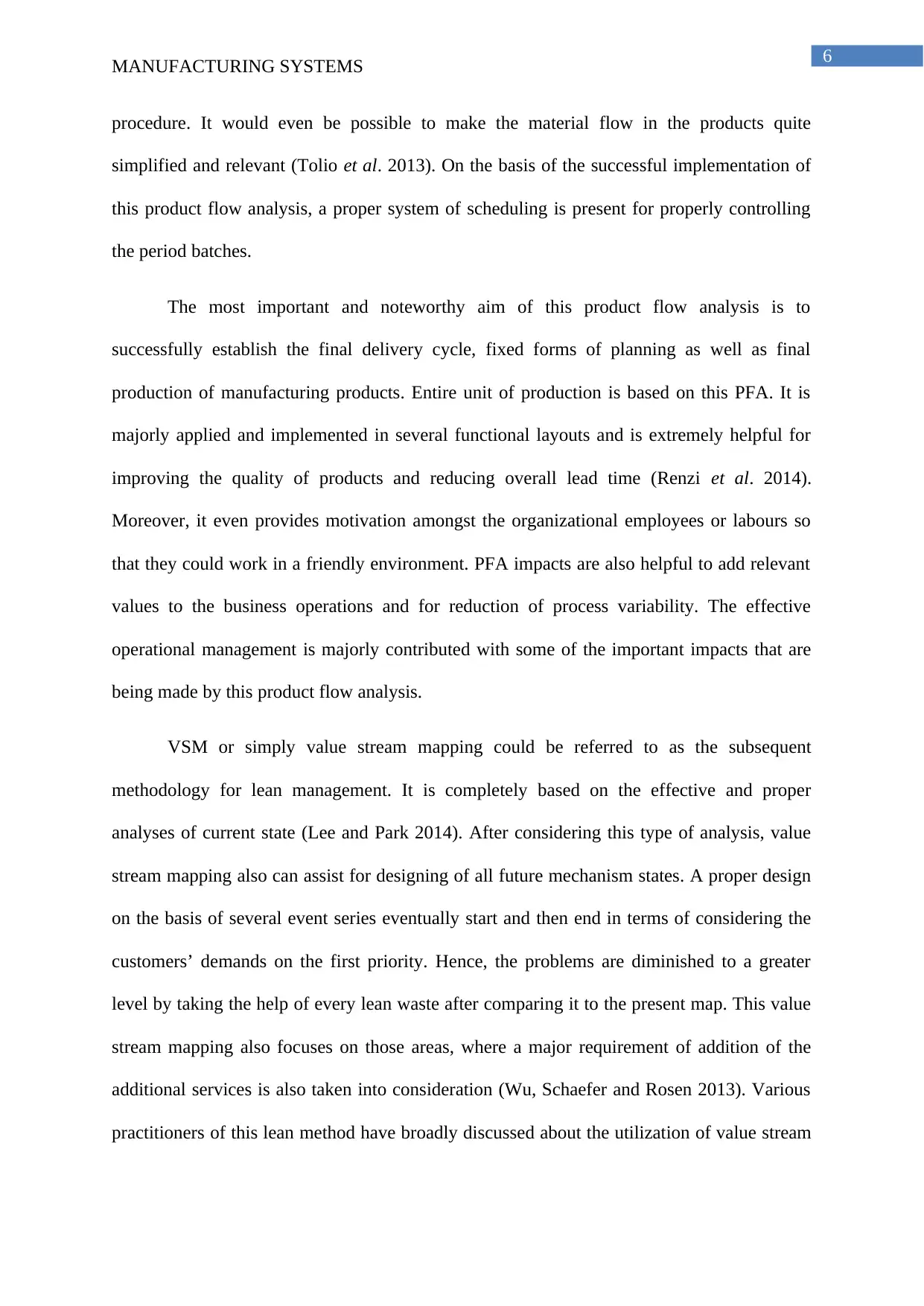
6
MANUFACTURING SYSTEMS
procedure. It would even be possible to make the material flow in the products quite
simplified and relevant (Tolio et al. 2013). On the basis of the successful implementation of
this product flow analysis, a proper system of scheduling is present for properly controlling
the period batches.
The most important and noteworthy aim of this product flow analysis is to
successfully establish the final delivery cycle, fixed forms of planning as well as final
production of manufacturing products. Entire unit of production is based on this PFA. It is
majorly applied and implemented in several functional layouts and is extremely helpful for
improving the quality of products and reducing overall lead time (Renzi et al. 2014).
Moreover, it even provides motivation amongst the organizational employees or labours so
that they could work in a friendly environment. PFA impacts are also helpful to add relevant
values to the business operations and for reduction of process variability. The effective
operational management is majorly contributed with some of the important impacts that are
being made by this product flow analysis.
VSM or simply value stream mapping could be referred to as the subsequent
methodology for lean management. It is completely based on the effective and proper
analyses of current state (Lee and Park 2014). After considering this type of analysis, value
stream mapping also can assist for designing of all future mechanism states. A proper design
on the basis of several event series eventually start and then end in terms of considering the
customers’ demands on the first priority. Hence, the problems are diminished to a greater
level by taking the help of every lean waste after comparing it to the present map. This value
stream mapping also focuses on those areas, where a major requirement of addition of the
additional services is also taken into consideration (Wu, Schaefer and Rosen 2013). Various
practitioners of this lean method have broadly discussed about the utilization of value stream
MANUFACTURING SYSTEMS
procedure. It would even be possible to make the material flow in the products quite
simplified and relevant (Tolio et al. 2013). On the basis of the successful implementation of
this product flow analysis, a proper system of scheduling is present for properly controlling
the period batches.
The most important and noteworthy aim of this product flow analysis is to
successfully establish the final delivery cycle, fixed forms of planning as well as final
production of manufacturing products. Entire unit of production is based on this PFA. It is
majorly applied and implemented in several functional layouts and is extremely helpful for
improving the quality of products and reducing overall lead time (Renzi et al. 2014).
Moreover, it even provides motivation amongst the organizational employees or labours so
that they could work in a friendly environment. PFA impacts are also helpful to add relevant
values to the business operations and for reduction of process variability. The effective
operational management is majorly contributed with some of the important impacts that are
being made by this product flow analysis.
VSM or simply value stream mapping could be referred to as the subsequent
methodology for lean management. It is completely based on the effective and proper
analyses of current state (Lee and Park 2014). After considering this type of analysis, value
stream mapping also can assist for designing of all future mechanism states. A proper design
on the basis of several event series eventually start and then end in terms of considering the
customers’ demands on the first priority. Hence, the problems are diminished to a greater
level by taking the help of every lean waste after comparing it to the present map. This value
stream mapping also focuses on those areas, where a major requirement of addition of the
additional services is also taken into consideration (Wu, Schaefer and Rosen 2013). Various
practitioners of this lean method have broadly discussed about the utilization of value stream
Paraphrase This Document
Need a fresh take? Get an instant paraphrase of this document with our AI Paraphraser
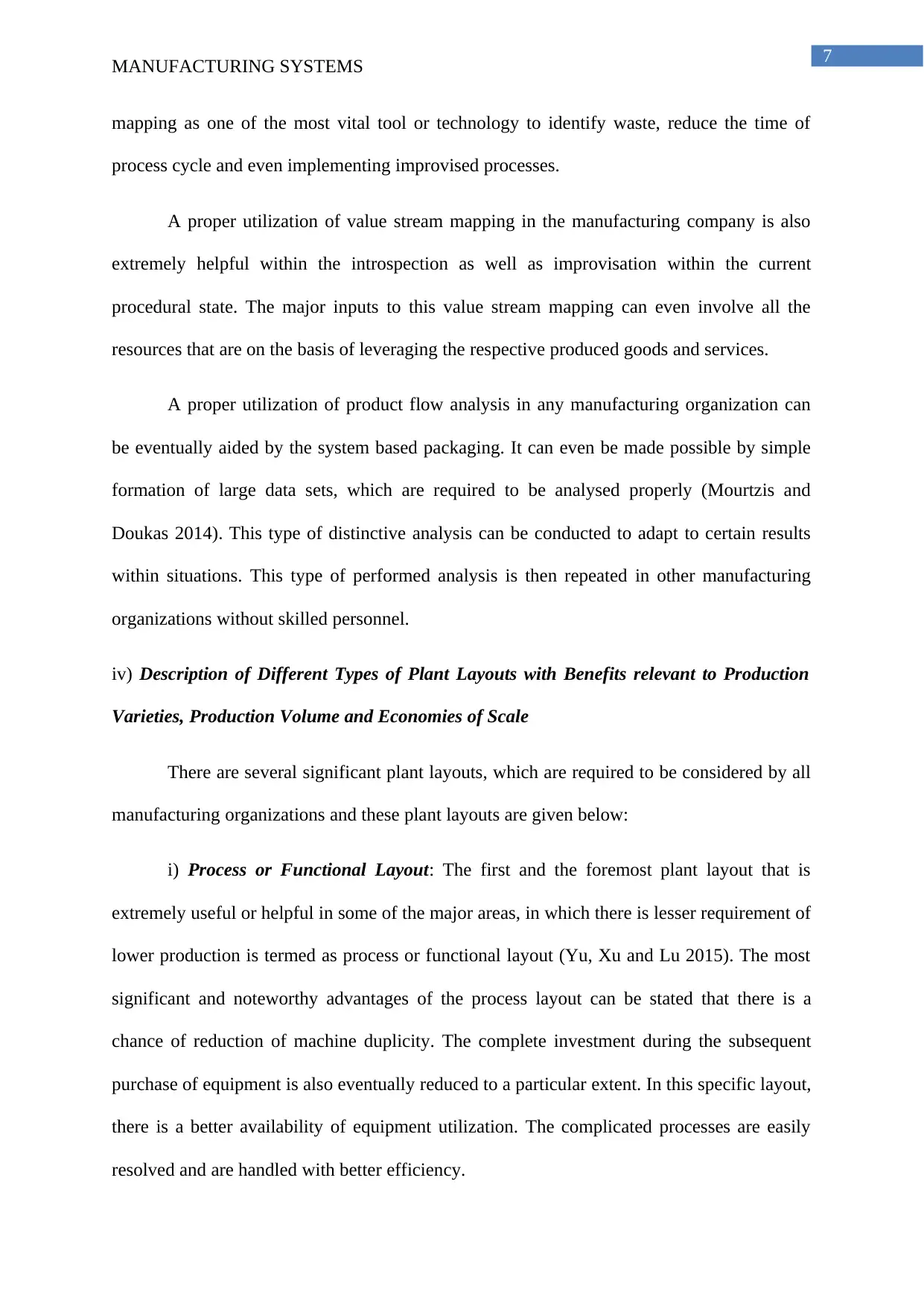
7
MANUFACTURING SYSTEMS
mapping as one of the most vital tool or technology to identify waste, reduce the time of
process cycle and even implementing improvised processes.
A proper utilization of value stream mapping in the manufacturing company is also
extremely helpful within the introspection as well as improvisation within the current
procedural state. The major inputs to this value stream mapping can even involve all the
resources that are on the basis of leveraging the respective produced goods and services.
A proper utilization of product flow analysis in any manufacturing organization can
be eventually aided by the system based packaging. It can even be made possible by simple
formation of large data sets, which are required to be analysed properly (Mourtzis and
Doukas 2014). This type of distinctive analysis can be conducted to adapt to certain results
within situations. This type of performed analysis is then repeated in other manufacturing
organizations without skilled personnel.
iv) Description of Different Types of Plant Layouts with Benefits relevant to Production
Varieties, Production Volume and Economies of Scale
There are several significant plant layouts, which are required to be considered by all
manufacturing organizations and these plant layouts are given below:
i) Process or Functional Layout: The first and the foremost plant layout that is
extremely useful or helpful in some of the major areas, in which there is lesser requirement of
lower production is termed as process or functional layout (Yu, Xu and Lu 2015). The most
significant and noteworthy advantages of the process layout can be stated that there is a
chance of reduction of machine duplicity. The complete investment during the subsequent
purchase of equipment is also eventually reduced to a particular extent. In this specific layout,
there is a better availability of equipment utilization. The complicated processes are easily
resolved and are handled with better efficiency.
MANUFACTURING SYSTEMS
mapping as one of the most vital tool or technology to identify waste, reduce the time of
process cycle and even implementing improvised processes.
A proper utilization of value stream mapping in the manufacturing company is also
extremely helpful within the introspection as well as improvisation within the current
procedural state. The major inputs to this value stream mapping can even involve all the
resources that are on the basis of leveraging the respective produced goods and services.
A proper utilization of product flow analysis in any manufacturing organization can
be eventually aided by the system based packaging. It can even be made possible by simple
formation of large data sets, which are required to be analysed properly (Mourtzis and
Doukas 2014). This type of distinctive analysis can be conducted to adapt to certain results
within situations. This type of performed analysis is then repeated in other manufacturing
organizations without skilled personnel.
iv) Description of Different Types of Plant Layouts with Benefits relevant to Production
Varieties, Production Volume and Economies of Scale
There are several significant plant layouts, which are required to be considered by all
manufacturing organizations and these plant layouts are given below:
i) Process or Functional Layout: The first and the foremost plant layout that is
extremely useful or helpful in some of the major areas, in which there is lesser requirement of
lower production is termed as process or functional layout (Yu, Xu and Lu 2015). The most
significant and noteworthy advantages of the process layout can be stated that there is a
chance of reduction of machine duplicity. The complete investment during the subsequent
purchase of equipment is also eventually reduced to a particular extent. In this specific layout,
there is a better availability of equipment utilization. The complicated processes are easily
resolved and are handled with better efficiency.

8
MANUFACTURING SYSTEMS
ii) Fixed Position Layout: Another significant kind of this plant layout is the fixed
position layout. The most important element is situated within a specific fixed position and
hence the name is provided. Any other equipment is also transferred to that particular
location. The major benefit of this fixed position layout is the reduction of material
movements (Hu 2013). Moreover the capital investments are also reduces and the tasks are
performed with better efficiency according to the business expectations.
iii) Product or Line Layout: The third important and significant plant layout that
eventually enables the processing equipment and machines for arranging in a significant
sequence is termed as product or line layout. This particular layout comprises of some of the
major and the most significant benefits on the basis of reduction of material handling
expenses, minimization of the overall production time as well as the advanced uses of
machines and man power.
v) Critical Review and Comparison of Several Tools and Techniques available for Process
Improvement in the Scope of Lean Manufacturing Systems
Primary operations in the business within all the smaller as well as medium sized
organizations of manufacturing can comprise of a similar goal or objective on the basis of the
proper adaption of lean methodology form and hence a specific invaluable system is being
formed (Pach et al. 2014). The respective path is also designed to receive the highest amount
of output on the basis of minimum wastage in the total production cycle. Impact of this lean
methodology also maintains the effectiveness and efficiency of several tools and techniques
so that a critical overview of the techniques and tools are being provided eventually. A proper
use of these types of techniques helps to improvise the entire processing and then increment
the total scope for manufacturing lean system. The core ideology behind this type of method
MANUFACTURING SYSTEMS
ii) Fixed Position Layout: Another significant kind of this plant layout is the fixed
position layout. The most important element is situated within a specific fixed position and
hence the name is provided. Any other equipment is also transferred to that particular
location. The major benefit of this fixed position layout is the reduction of material
movements (Hu 2013). Moreover the capital investments are also reduces and the tasks are
performed with better efficiency according to the business expectations.
iii) Product or Line Layout: The third important and significant plant layout that
eventually enables the processing equipment and machines for arranging in a significant
sequence is termed as product or line layout. This particular layout comprises of some of the
major and the most significant benefits on the basis of reduction of material handling
expenses, minimization of the overall production time as well as the advanced uses of
machines and man power.
v) Critical Review and Comparison of Several Tools and Techniques available for Process
Improvement in the Scope of Lean Manufacturing Systems
Primary operations in the business within all the smaller as well as medium sized
organizations of manufacturing can comprise of a similar goal or objective on the basis of the
proper adaption of lean methodology form and hence a specific invaluable system is being
formed (Pach et al. 2014). The respective path is also designed to receive the highest amount
of output on the basis of minimum wastage in the total production cycle. Impact of this lean
methodology also maintains the effectiveness and efficiency of several tools and techniques
so that a critical overview of the techniques and tools are being provided eventually. A proper
use of these types of techniques helps to improvise the entire processing and then increment
the total scope for manufacturing lean system. The core ideology behind this type of method
⊘ This is a preview!⊘
Do you want full access?
Subscribe today to unlock all pages.

Trusted by 1+ million students worldwide
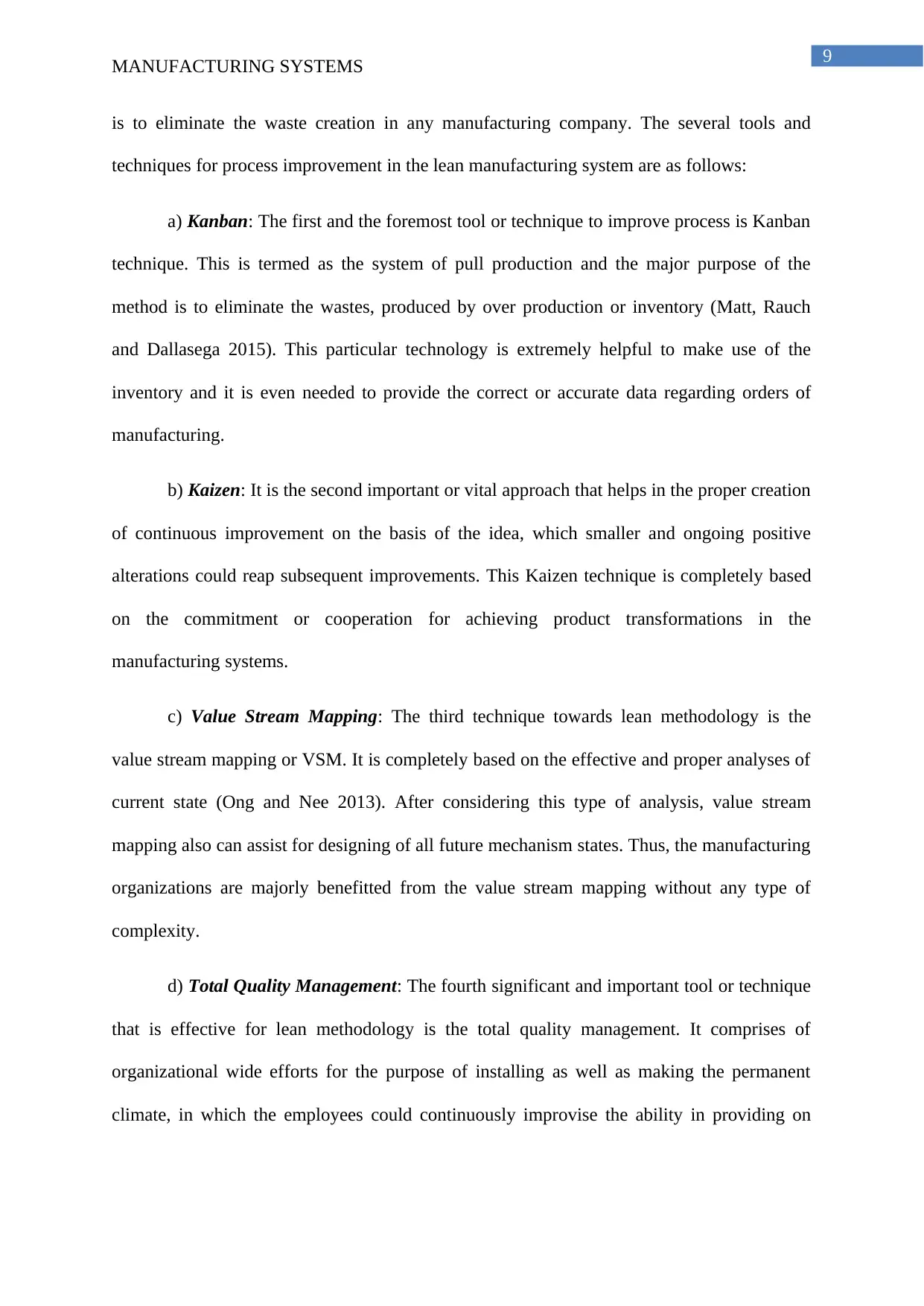
9
MANUFACTURING SYSTEMS
is to eliminate the waste creation in any manufacturing company. The several tools and
techniques for process improvement in the lean manufacturing system are as follows:
a) Kanban: The first and the foremost tool or technique to improve process is Kanban
technique. This is termed as the system of pull production and the major purpose of the
method is to eliminate the wastes, produced by over production or inventory (Matt, Rauch
and Dallasega 2015). This particular technology is extremely helpful to make use of the
inventory and it is even needed to provide the correct or accurate data regarding orders of
manufacturing.
b) Kaizen: It is the second important or vital approach that helps in the proper creation
of continuous improvement on the basis of the idea, which smaller and ongoing positive
alterations could reap subsequent improvements. This Kaizen technique is completely based
on the commitment or cooperation for achieving product transformations in the
manufacturing systems.
c) Value Stream Mapping: The third technique towards lean methodology is the
value stream mapping or VSM. It is completely based on the effective and proper analyses of
current state (Ong and Nee 2013). After considering this type of analysis, value stream
mapping also can assist for designing of all future mechanism states. Thus, the manufacturing
organizations are majorly benefitted from the value stream mapping without any type of
complexity.
d) Total Quality Management: The fourth significant and important tool or technique
that is effective for lean methodology is the total quality management. It comprises of
organizational wide efforts for the purpose of installing as well as making the permanent
climate, in which the employees could continuously improvise the ability in providing on
MANUFACTURING SYSTEMS
is to eliminate the waste creation in any manufacturing company. The several tools and
techniques for process improvement in the lean manufacturing system are as follows:
a) Kanban: The first and the foremost tool or technique to improve process is Kanban
technique. This is termed as the system of pull production and the major purpose of the
method is to eliminate the wastes, produced by over production or inventory (Matt, Rauch
and Dallasega 2015). This particular technology is extremely helpful to make use of the
inventory and it is even needed to provide the correct or accurate data regarding orders of
manufacturing.
b) Kaizen: It is the second important or vital approach that helps in the proper creation
of continuous improvement on the basis of the idea, which smaller and ongoing positive
alterations could reap subsequent improvements. This Kaizen technique is completely based
on the commitment or cooperation for achieving product transformations in the
manufacturing systems.
c) Value Stream Mapping: The third technique towards lean methodology is the
value stream mapping or VSM. It is completely based on the effective and proper analyses of
current state (Ong and Nee 2013). After considering this type of analysis, value stream
mapping also can assist for designing of all future mechanism states. Thus, the manufacturing
organizations are majorly benefitted from the value stream mapping without any type of
complexity.
d) Total Quality Management: The fourth significant and important tool or technique
that is effective for lean methodology is the total quality management. It comprises of
organizational wide efforts for the purpose of installing as well as making the permanent
climate, in which the employees could continuously improvise the ability in providing on
Paraphrase This Document
Need a fresh take? Get an instant paraphrase of this document with our AI Paraphraser
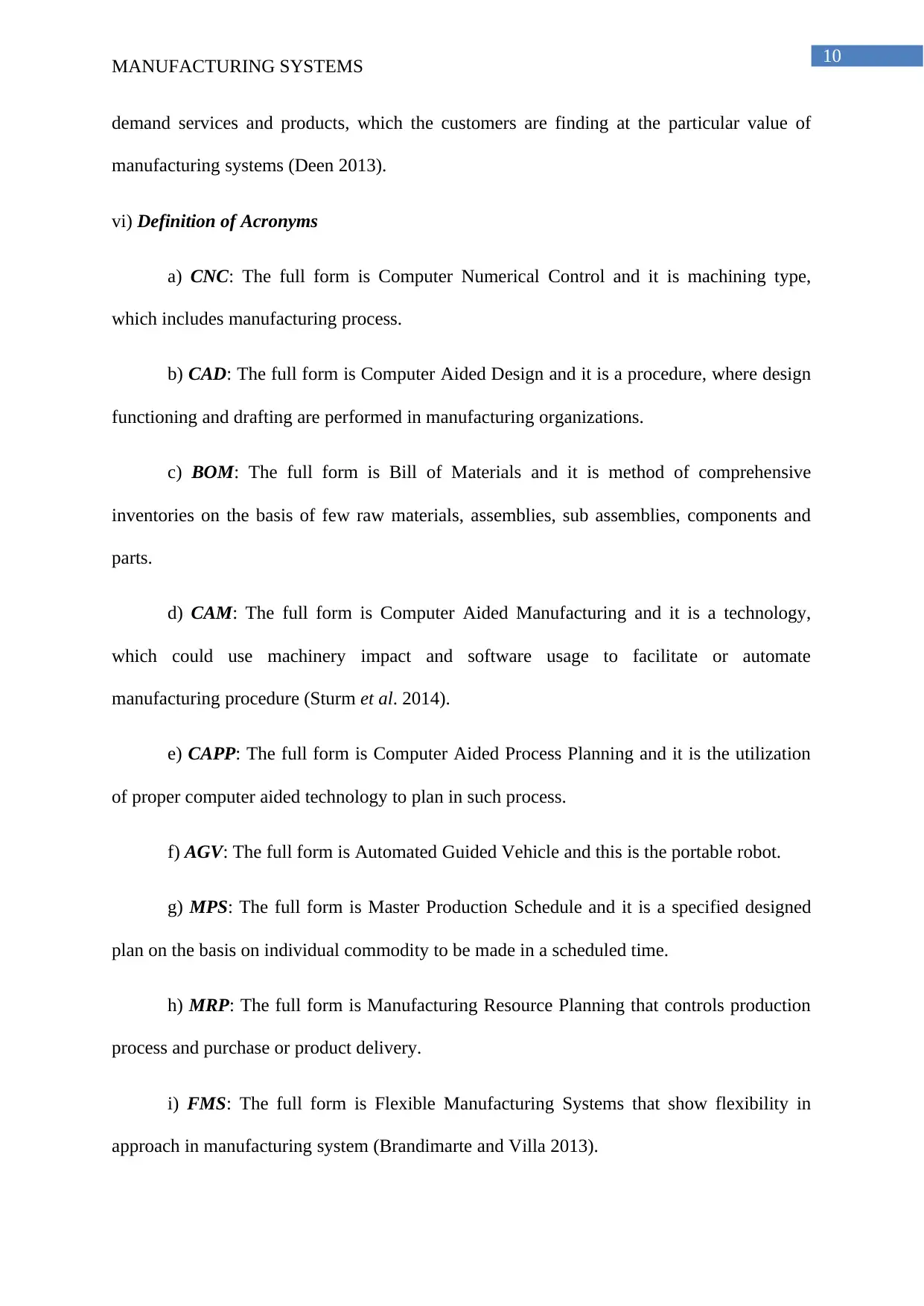
10
MANUFACTURING SYSTEMS
demand services and products, which the customers are finding at the particular value of
manufacturing systems (Deen 2013).
vi) Definition of Acronyms
a) CNC: The full form is Computer Numerical Control and it is machining type,
which includes manufacturing process.
b) CAD: The full form is Computer Aided Design and it is a procedure, where design
functioning and drafting are performed in manufacturing organizations.
c) BOM: The full form is Bill of Materials and it is method of comprehensive
inventories on the basis of few raw materials, assemblies, sub assemblies, components and
parts.
d) CAM: The full form is Computer Aided Manufacturing and it is a technology,
which could use machinery impact and software usage to facilitate or automate
manufacturing procedure (Sturm et al. 2014).
e) CAPP: The full form is Computer Aided Process Planning and it is the utilization
of proper computer aided technology to plan in such process.
f) AGV: The full form is Automated Guided Vehicle and this is the portable robot.
g) MPS: The full form is Master Production Schedule and it is a specified designed
plan on the basis on individual commodity to be made in a scheduled time.
h) MRP: The full form is Manufacturing Resource Planning that controls production
process and purchase or product delivery.
i) FMS: The full form is Flexible Manufacturing Systems that show flexibility in
approach in manufacturing system (Brandimarte and Villa 2013).
MANUFACTURING SYSTEMS
demand services and products, which the customers are finding at the particular value of
manufacturing systems (Deen 2013).
vi) Definition of Acronyms
a) CNC: The full form is Computer Numerical Control and it is machining type,
which includes manufacturing process.
b) CAD: The full form is Computer Aided Design and it is a procedure, where design
functioning and drafting are performed in manufacturing organizations.
c) BOM: The full form is Bill of Materials and it is method of comprehensive
inventories on the basis of few raw materials, assemblies, sub assemblies, components and
parts.
d) CAM: The full form is Computer Aided Manufacturing and it is a technology,
which could use machinery impact and software usage to facilitate or automate
manufacturing procedure (Sturm et al. 2014).
e) CAPP: The full form is Computer Aided Process Planning and it is the utilization
of proper computer aided technology to plan in such process.
f) AGV: The full form is Automated Guided Vehicle and this is the portable robot.
g) MPS: The full form is Master Production Schedule and it is a specified designed
plan on the basis on individual commodity to be made in a scheduled time.
h) MRP: The full form is Manufacturing Resource Planning that controls production
process and purchase or product delivery.
i) FMS: The full form is Flexible Manufacturing Systems that show flexibility in
approach in manufacturing system (Brandimarte and Villa 2013).
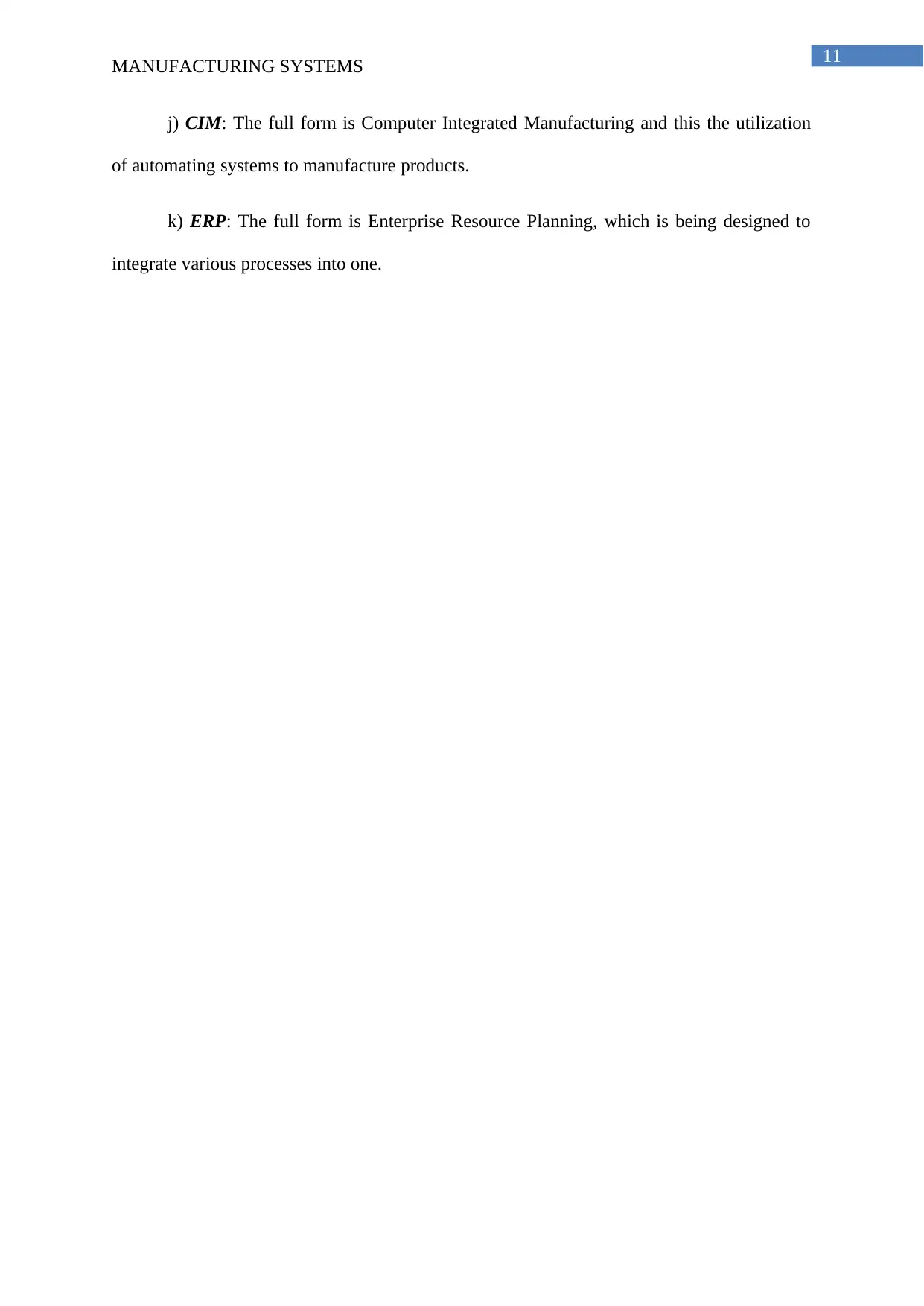
11
MANUFACTURING SYSTEMS
j) CIM: The full form is Computer Integrated Manufacturing and this the utilization
of automating systems to manufacture products.
k) ERP: The full form is Enterprise Resource Planning, which is being designed to
integrate various processes into one.
MANUFACTURING SYSTEMS
j) CIM: The full form is Computer Integrated Manufacturing and this the utilization
of automating systems to manufacture products.
k) ERP: The full form is Enterprise Resource Planning, which is being designed to
integrate various processes into one.
⊘ This is a preview!⊘
Do you want full access?
Subscribe today to unlock all pages.

Trusted by 1+ million students worldwide
1 out of 21
Related Documents
Your All-in-One AI-Powered Toolkit for Academic Success.
+13062052269
info@desklib.com
Available 24*7 on WhatsApp / Email
![[object Object]](/_next/static/media/star-bottom.7253800d.svg)
Unlock your academic potential
Copyright © 2020–2025 A2Z Services. All Rights Reserved. Developed and managed by ZUCOL.





